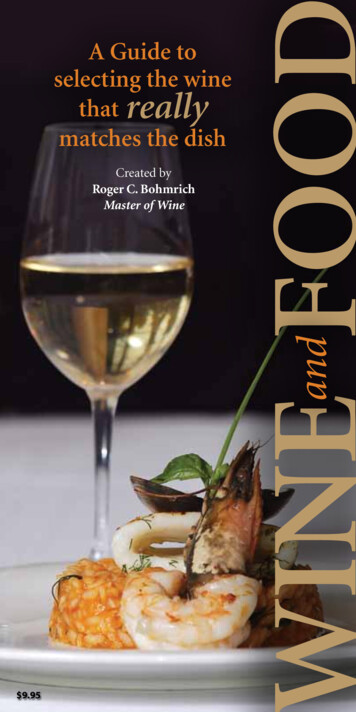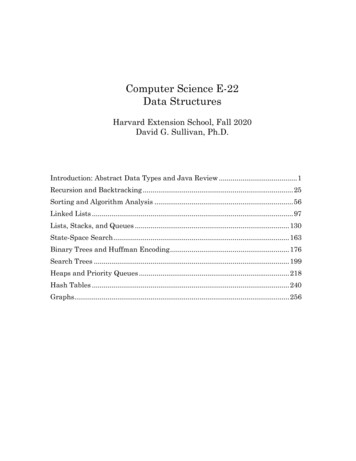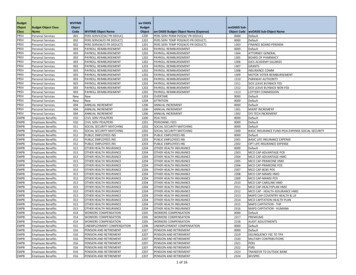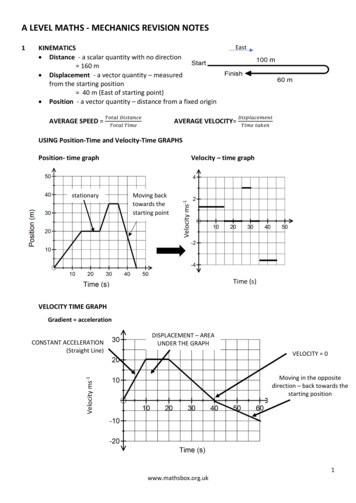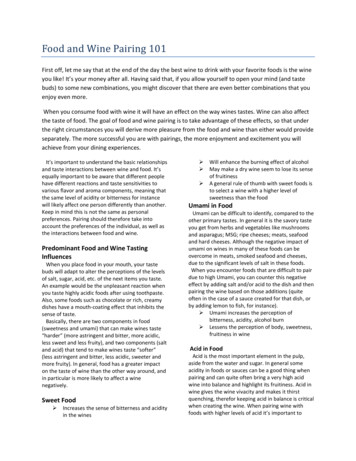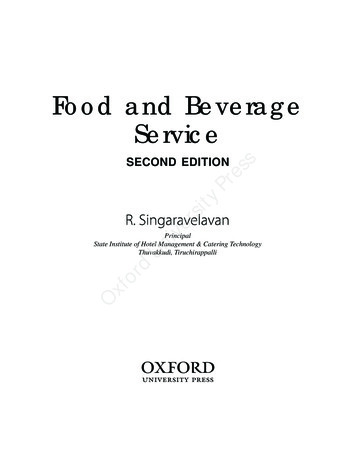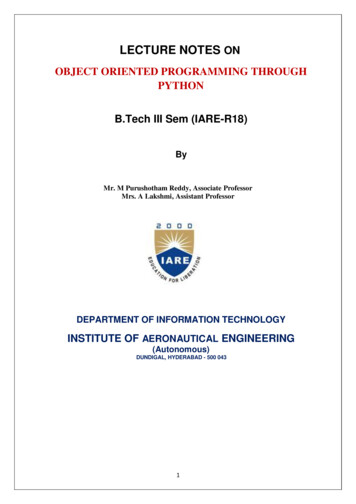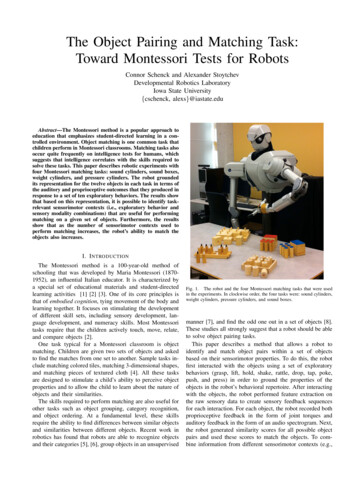
Transcription
The Object Pairing and Matching Task:Toward Montessori Tests for RobotsConnor Schenck and Alexander StoytchevDevelopmental Robotics LaboratoryIowa State University{cschenck, alexs}@iastate.eduAbstract—The Montessori method is a popular approach toeducation that emphasizes student-directed learning in a controlled environment. Object matching is one common task thatchildren perform in Montessori classrooms. Matching tasks alsooccur quite frequently on intelligence tests for humans, whichsuggests that intelligence correlates with the skills required tosolve these tasks. This paper describes robotic experiments withfour Montessori matching tasks: sound cylinders, sound boxes,weight cylinders, and pressure cylinders. The robot groundedits representation for the twelve objects in each task in terms ofthe auditory and proprioceptive outcomes that they produced inresponse to a set of ten exploratory behaviors. The results showthat based on this representation, it is possible to identify taskrelevant sensorimotor contexts (i.e., exploratory behavior andsensory modality combinations) that are useful for performingmatching on a given set of objects. Furthermore, the resultsshow that as the number of sensorimotor contexts used toperform matching increases, the robot’s ability to match theobjects also increases.I. I NTRODUCTIONThe Montessori method is a 100-year-old method ofschooling that was developed by Maria Montessori (18701952), an influential Italian educator. It is characterized bya special set of educational materials and student-directedlearning activities [1] [2] [3]. One of its core principles isthat of embodied cognition, tying movement of the body andlearning together. It focuses on stimulating the developmentof different skill sets, including sensory development, language development, and numeracy skills. Most Montessoritasks require that the children actively touch, move, relate,and compare objects [2].One task typical for a Montessori classroom is objectmatching. Children are given two sets of objects and askedto find the matches from one set to another. Sample tasks include matching colored tiles, matching 3-dimensional shapes,and matching pieces of textured cloth [4]. All these tasksare designed to stimulate a child’s ability to perceive objectproperties and to allow the child to learn about the nature ofobjects and their similarities.The skills required to perform matching are also useful forother tasks such as object grouping, category recognition,and object ordering. At a fundamental level, these skillsrequire the ability to find differences between similar objectsand similarities between different objects. Recent work inrobotics has found that robots are able to recognize objectsand their categories [5], [6], group objects in an unsupervisedFig. 1. The robot and the four Montessori matching tasks that were usedin the experiments. In clockwise order, the four tasks were: sound cylinders,weight cylinders, pressure cylinders, and sound boxes.manner [7], and find the odd one out in a set of objects [8].These studies all strongly suggest that a robot should be ableto solve object pairing tasks.This paper describes a method that allows a robot toidentify and match object pairs within a set of objectsbased on their sensorimotor properties. To do this, the robotfirst interacted with the objects using a set of exploratorybehaviors (grasp, lift, hold, shake, rattle, drop, tap, poke,push, and press) in order to ground the properties of theobjects in the robot’s behavioral repertoire. After interactingwith the objects, the robot performed feature extraction onthe raw sensory data to create sensory feedback sequencesfor each interaction. For each object, the robot recorded bothproprioceptive feedback in the form of joint torques andauditory feedback in the form of an audio spectrogram. Next,the robot generated similarity scores for all possible objectpairs and used these scores to match the objects. To combine information from different sensorimotor contexts (e.g.,
audio-drop and proprioception-shake), the robot used threedifferent methods: uniform-weight combination, recognitionaccuracy based weight combination, and pairing accuracybased combination. These methods were evaluated for theirability to match standard Montessori objects.This study used four typical Montessori matching tasks.In each task there were two groups of six objects and thegoal was to find the matching pairs of objects between thetwo groups. The results indicate that the estimated objectsimilarities were sufficient to adequately pair objects. Therobot was able to solve the object matching task with ahigh degree of accuracy. Furthermore, the robot was able toidentify the functionally meaningful sensorimotor contexts inwhich it can distinguish between objects. To the best of ourknowledge, this is the first study that has applied Montessorilearning techniques in a robotic setting.II. R ELATED W ORKwithin a category and based on that information they candetermine the inclusion of a novel object in the givencategory. These studies show that even at an early age,humans are able to identify object properties and use them tocompare objects, which suggests that this is a fundamentalpart of intelligence.Another experiment by McPherson and Holcomb [13]examined event-related brain potentials. Participants wereshown a picture of an object, then a picture of an objectfrom one of three categories: related, moderately related, orunrelated. The electroencephalogram (EEG) results showedthat across all participants, there was a large negative spikein the N400 family of potentials in the participants’ brainshortly after being shown the second picture. The study foundthat the magnitude of the spike was related to the similaritybetween the two objects in the pictures. This suggests that,at least at some level, the brain makes a quantitative measureof how similar the two objects are.A. PsychologyRecent studies have found that students educated usingthe Montessori method often outperform students educatedby traditional methods. For example, one study found thatmiddle school students from Montessori schools had higherintrinsic motivation when it came to academic activities ascompared to students from traditional schools [9]. This suggests that the Montessori method is more effective at fostering learning in young children than the traditional methods.This conclusion was supported by another study [3], whichfound that, by the end of kindergarten, Montessori studentsoutperformed traditional students on standardized tests ofreading and math and also showed more advanced socialskills and executive control.One task commonly used in the Montessori style ofteaching for younger children is the matching task [4]. Inthis task, a child is given a set of objects (sometimes splitinto two subsets and sometimes not) and asked to pair theobjects. A variant of that task was used by Daehler etal. [10] who used both objects and pictures of objects in theirexperiments. They found that children around the age of twoare able to correctly match objects from both pictures andobjects to sets of pictures or objects. One interesting result ofthis experiment was that the children performed significantlybetter on tasks where they were asked to match an object toa set of objects, versus picture to object, object to picture,or picture to picture matching. They suggested that this wasdue to the ability of the children to perceive the objects frommultiple angles, thus giving them more reliable informationabout the objects than they could extract from the pictures.Other studies have shown infants’ ability to identify objectpairs and group objects into categories. A study by Leslieet al. [11] demonstrated that eleven-month-old infants canindividuate pairs of objects only when there is a large amountof physical similarity between objects in the same pair (inthis study they used identical objects) and a large physicaldifference between objects of different pairs. Younger [12]showed that ten-month-old infants can form object categoriesand determine the variants and invariants of the objectsB. RoboticsSeveral studies have demonstrated that robots can measureperceptual as well as functional object similarities for avariety of tasks [14], [15], [16], [17], [18], [8]. The abilityto measure the similarity between two objects is extremelyuseful for tasks such as category recognition and objectgrouping. Several studies [16], [5] have used unsupervisedapproaches for object categorization, in which objects werecategorized by the similarity of their perceptual features.Their results showed that when the robot was allowed touse all of its sensory modalities, its object categorizationsclosely resembled the human-provided ones. This suggeststhat allowing robots to perceive more features about objectscan improve their ability to detect similarities between theobjects.Sinapov and Stoytchev [8] showed how a robot can solvethe odd-one-out task. The robot picked the object in thegroup that was least similar to the rest and resulted in therest of the objects being maximally similar. In this paper weuse a similar method to generate similarity scores betweenobjects. We then use this similarity measure to perform objectmatching rather than solving the odd-one-out task, thoughthey are fundamentally related problems.III. E XPERIMENTAL P LATFORMA. Robot and SensorsThe experiments in this study were performed with theupper-torso humanoid robot shown in Fig. 1. The robot hasas its actuators two 7-DOF Barrett Whole Arm Manipulators(WAMs), each with an attached Barrett Hand. Each WAMhas built-in sensors that measure joint angles and torques at500 Hz. An Audio-Technica U853AW cardioid microphonemounted in the robot’s head was used to capture auditoryfeedback at the standard 16-bit/44.1 kHz over a singlechannel.
placed at a marked location on the table by the experimenterand the robot performed all ten of its exploratory behaviorson the object. The experimenter then picked another objectand the robot repeated this process. This was done until eachobject had been explored ten times. During each interaction,the robot recorded proprioceptive information in the form ofjoint torques applied to the arm and auditory data capturedby the microphone. The robot also recorded visual data, butit was not used in this experiment. In the end, the robotperformed all ten behaviors ten times on each of the twelveobjects in the four sets, resulting in 10 10 12 4 4800behavior executions. This resulted in 18 GB of data, whichwas stored for off-line analysis. It took approximately 20hours to collect this dataset.Fig. 2. The four sets of Montessori objects used in the experiments. Fromleft to right and top to bottom the object sets are: pressure cylinders, soundboxes, sound cylinders, and weight cylinders. All the objects are markedwith colored dots on the bottom to indicate the correct matches; other thanthat, the objects in each set are all visually identical (except for the pressurecylinders and the sound cylinders, which also have different colors for thetops to indicate the two sets of six objects).C. Exploratory BehaviorsIV. F EATURE E XTRACTIONWe used the method and the publicly available sourcecode for proprioceptive and auditory feature extraction that isdescribed in [5]. It is briefly summarized below. Proprioceptive data was recorded as joint torques over time resultingin a 7 m matrix, in which each column represents oneset of torque readings for all joints and m is the numberof readings. To reduce noise, a moving-average filter wasapplied over each row in the matrix, which corresponds tothe torques from one joint. Audio data was recorded as wavefiles, one for each interaction. A log-normalized DiscreteFourier Transform was performed on each audio file using25 1 33 frequency bins resulting in a 33 n matrix, whereeach column represents the activation values for differentfrequencies at a given point in time and n is the number ofsamples in the interaction. The Growing Hierarchical SelfOrganizing Map (SOM) toolbox [20] was used to map eachcolumn to a single state. Two 6 6 SOMs were trained(one for audio and one for proprioception) using 5% of thecolumns that were randomly selected from all the joint torqueand auditory data recorded by the robot. Each joint torqueand auditory record was then mapped to a discrete sequenceof states, where each column in the record was representedby the most highly activated SOM state for that column. Formore details see [5].The robot used ten behaviors to explore the objects: grasp,lift, hold, shake, rattle, drop, tap, poke, push, and press. Allof these exploratory behaviors, except rattle, have been usedin our previous work [19], i.e., they were not specificallydesigned for the Montessori objects used in this paper. Thebehaviors were performed with the robot’s left arm andencoded with the Barrett WAM API as trajectories in jointspace. The default PID controller of the WAM was usedto execute the trajectories. Figure 3 shows images of therobot performing each behavior on one of the sound boxes.All the behaviors were performed identically on each object,with only minor variations due to the initial placement of theobjects by the experimenter.V. E XPERIMENTAL M ETHODOLOGYA. Estimating SimilarityGiven a set of objects O the robot must be able to estimatethe pairwise similarity for any two objects i, j O in a givensensorimotor context (i.e., exploratory behavior and sensorymodality combination). Let Xci [X1 , ., XD ] be the set ofsensory feedback sequences detected while interacting withobject i O in sensorimotor context c C (where C is theset of all contexts) and let sim(Xa , Xb ) be the similaritybetween two sequences Xa and Xb . The similarity betweenobjects i and j can be approximated with the expectedpairwise similarity of the sequences in Xci and Xcj :B. ObjectsThe robot explored four standard Montessori sets of objects: pressure cylinders, sound boxes, sound cylinders, andweight cylinders (Fig. 2). Each set is composed of six pairs ofobjects. The objects in each pair are functionally identical toeach other. The objects in each set are designed to vary in onespecific dimension and be identical in all other dimensions.The pressure cylinders vary in the amount of force requiredto depress the rod, with pairs requiring the same amount offorce. The sound boxes vary in the sounds they make whenthe contents move around inside the box, with pairs makingthe same sounds. The sound cylinders vary in the same wayas the sound boxes, but are cylindrical in shape and havedifferent contents than the boxes. The weight cylinders varyby weight, going from light to heavy, with pairs having thesame weight.scij E[sim(Xa , Xb ) Xa Xci , Xb Xcj ]D. Data CollectionThe robot interacted with the objects by performing aseries of exploration trials. During each trial, an object wasIn this paper we used the Needleman-Wunsch global alignment algorithm [21] to calculate sim(Xa , Xb ). The algorithm calculates the cost of aligning two discrete sequences
Fig. 3. The ten exploratory behaviors that the robot performed on all objects. From left to right and top to bottom: grasp, lift, hold, shake, rattle, drop,tap, poke, push, and crush. The object in this figure is one of the sound boxes. The red marker on the table indicates the initial position of the objects atthe beginning of each trial. The object was placed back in that position by the experimenter after some of the behaviors (e.g., drop).(strings), which in our case correspond to sequences of mosthighly-activated SOM states (see the previous section). Theexpected similarity scij is estimated as1 Xci XX Xcj X X ijac Xb Xcsim(Xa , Xb )Next, the robot estimates the O O pairwise objectsimilarity matrix Wc for a specific sensorimotor context c C. Each entry Wijc in Wc is defined as the similarity scijbetween two objects i and j in the specific context c. Figure 4shows the similarity matrices for the sound cylinders for eachof the 20 contexts.B. Combining Sensorimotor ContextsIt has been shown that combining information from different sensorimotor contexts has a boosting effect for taskssuch as object recognition [22]. Since object matching isa similar task, it is likely that combining contexts will beuseful in this case as well. Thus, in this paper, we proposethree methods to combine sensorimotor contexts: uniformcombination, recognition accuracy based combination, andpairing accuracy based combination. The result of combiningdifferent contexts is a consensus matrix W that representsthe similarity between object pairs for the specific set ofcontexts that was used to create it.1) Uniform Combination: Given some set of contexts C ′ ,where C ′ C, the similarity matrices Wc for each of thesecontexts can be used to construct the consensus matrix Wby simply averaging their individual values, i.e.,1 X cWij ′Wij C ′c Cfor all pairs of objects i and j.2) Recognition Accuracy Based Combination: Thismethod assumes that contexts that are useful for objectrecognition will also be useful for object pairing. The objectrecognition accuracy rc for context c is estimated by performing 10-fold cross validation on all the data from contextc using a classifier that attempts to recognize object identitiesfrom sensory feedback sequences. To create the consensusmatrix for a given set of contexts C ′ (C ′ C), a weightedcombination was used:XWij αc Wijcc C ′where αc is the normalizedrecognition accuracy rc forPcontext c such that c C ′ αc 1.0. The classifier used inthis paper was the k-nearest neighbor classifier with k setto 3 and using the global alignment similarity function as asimilarity metric.3) Pairing Accuracy Based Combination: The third combination method allowed the robot to get feedback on itsattempts to pair some of the objects to refine its ability to pairthe remaining objects. In order to determine the usefulnessof each context, the robot split the set of objects such thateither 2, 3, or 4 of the six pairs were in the training set andthe rest remained in the testing set. Then, for each context c,using the objects in the training set, the robot would attemptto pair them (using the pairing method described below) andevaluate the pairing accuracy pc for that context. To constructthe consensus matrix W, a weighted combination was usedsimilar to the previous method:XWij αc Wijcc C ′where αc isPthe normalized pairing accuracy pc for contextc such that c C ′ αc 1.0. After generating the consensusmatrix W, the robot would then attempt to pair only the
ProprioceptionΣ Fig. 4. The similarity matrices used to perform matching given two sets of six objects each for the sound cylinders. The matrices for each individualcontext are shown as well as the consensus matrix for all 20 contexts. The pairing accuracy combination method using four pairs for training was usedto combine the individual matrices.ObOa123456123is shown in Fig. 4. Formally, the objects i Oa and j Obthat maximize XXWkj q(i, j, W) Wij γ Wik k Ob /jwere selected and then removed from Oa and Ob . The firstterm captures the pairwise similarity between objects i and j;the last term captures the pairwise similarity between objectsi and j and the rest of the objects. The constant γ is anormalizing weight, which ensures that this function is notbiased toward any of the terms. In our case, it was set to45k Oa /iγ 1.2( O 1)This process was repeated until no more objects remained tobe paired.6D. EvaluationFig. 5. The consensus weight matrix for the sound cylinders using all 20sensorimotor contexts for matching two groups of six objects. The pairingaccuracy combination method using four pairs to train was used to combinethe individual similarity matrices for each context. The subscripts indicatecorrect matches.objects from the testing set. Figures 4 and 5 show a consensusmatrix generated by combining the similarity matrices fromall 20 contexts when training using 4 pairs of objects.C. Generating MatchingsThe robot was tasked with generating matchings amongthe objects in the four Montessori toys. The objects weresplit into two groups of six and the robot was tasked withselecting one object from each group to generate a match.This split into two groups of six is naturally suggested bythe Montessori toys. For example, the sound cylinders haveeither red or blue caps; the pressure cylinders have eitherblack or white buttons (see Fig. 2).More formally, given a 6x6 non-symmetric similarity matrix Wc or a consensus matrix W and objects O partitionedinto two sets of equal size Oa and Ob , matches weregenerated by picking pairs that maximized similarity betweenthe objects in the pair and minimized similarity betweenthose objects and the remaining objects. One such matrixGiven a set of objects (e.g., the weight cylinders), therobot’s model was queried in order to group the objectsinto pairs. Five interactions were randomly picked for eachobject from the set of ten interactions that were performedon each object and used to create the weight matrix Wc foreach sensorimotor context c C. Consensus matrices Wwere generated using the three methods described above fora given set of contexts. Matchings were then generated usingthe method described above. This process was repeated 100times for every group of contexts. For each size from 1 to C , 100 sets of contexts were randomly generated and tested(1, 721 in total)1 . Results are reported as the average accuracyor as Cohen’s kappa statistic [23] over all 100 iterations.Accuracy is computed as%Accuracy #correct matchings 100.#total matchingsThe kappa statistic is computed askappa P (a) P (e).1 P (e)In our experiments, P (a) is the pairing accuracy of therobot and P (e) is the accuracy a random matching would be1 For sets of size 1, C 1, and C all sets of that size were tested sincethere were fewer than 100 sets of those sizes.
LiftSound Boxes10.90.90.80.8Kappa ValueKappa ceptionAudioProprioceptionAudioGraspPressure Cylinders10.70.60.50.4ShakePokeRP2P31015Number of .70.60.50.3U0.2R1015Number of Contexts0.40.3Push5Weight Cylinders1Kappa ValueKappa ValueTap5Sound 015Number of ContextsP3P420U0.25RP21015Number of ContextsP3P420PressFig. 6. The accuracy of each context when matching between two sets ofsix objects. Lighter values indicate higher accuracy with completely whitebeing 100%. Darker values indicate lower accuracy with completely blackbeing 0%. The images from left to right are: pressure cylinders, sound boxes,sound cylinders, and weight cylinders.Fig. 7. The kappa statistic for each set of objects. Each line representsa different method for combing the sensorimotor contexts. The line labels are as follows: U-uniform combination; R-recognition accuracy basedcombination; P2-pairing accuracy using two pairs for training; P3-pairingaccuracy using three pairs for training; P4-pairing accuracy using four pairsfor training.B. Object Matching with Multiple Contextsexpected to get. Kappa is used to allow for direct comparisons between the different sensorimotor context combinationmethods, since for the pairing accuracy based method, chanceaccuracy is different than it is for the other methods. Thekappa statistic controls for chance accuracy.The evaluation was performed off-line after the robotinteracted with all 48 objects (4 Montessori tasks 12objects in each).VI. R ESULTSA. Object Matching with a Single ContextFigure 6 shows the matching accuracy for each context forall four Montessori tasks. For the pressure cylinders, the bestsensorimotor context was proprioception-press (97.5% pairing accuracy), which was expected. Surprisingly, audio-pressalso did well (80.7%), which was not expected since (at leastto the authors’ ears) all the cylinders sound the same whenpressed. Also interesting is the audio-drop context for thesound cylinders (89.3% accuracy), which outperformed bothshake (60.3%) and rattle (51.3%) behaviors for audio. Audiopress (82.3%) for the sound cylinders also did well, whichis likely due to the fact that they would fall over while beingpressed. It is also worth noting that for the weight cylinders, the best contexts were proprioception-shake (87.7%)and proprioception-push (94.3%) rather than contexts thatmore directly measure the weight such as proprioception-lift(50.7%) and proprioception-hold (18.8%).In summary, the robot was able to identify the relevantbehaviors and sensory modalities and use them to pair theobjects in each of the four Montessori tasks with a highdegree of accuracy.Figure 7 shows the kappa statistic for each set of objectsas the number of contexts is varied from 1 to 20. Thegraphs show that as the number of sensorimotor contextsused to perform matching increases, so does the kappastatistic. In all cases, the pairing accuracy based combinationusing four pairs for training (the cyan line) outperforms allthe other combination methods. The only exception to thisis for the sound boxes, since accuracy reaches 100%, allmethods reach a kappa value of 1.0. In most cases, thepairing accuracy based combination using three pairs fortraining (the yellow line) also outperforms the other methods(except for the method that uses four pairs for training).The pairing accuracy based combination using two pairs fortraining performs about the same as the recognition accuracycombination method, which usually performs slightly betterthan the uniform combination method. All the combinationmethods perform better than chance for all object sets, whichis indicated by a 0.0 kappa value.C. Repeating the Same BehaviorIn all results reported up to this point, five interactionswere randomly chosen from the ten for each object duringeach iteration. Figure 8 shows the average kappa statisticas the number of trials vary, averaged over all the setsof objects and number of contexts. The accuracies quicklyconverge after only a few trials, implying that repeatingthe same behavioral repertoire multiple times on an objecthas quickly diminishing returns. In most cases and for allcombination methods, after four repetitions there is very littlegain. Diminishing returns is most quickly realized for thepairing accuracy combination method using four pairs for
training. The largest gain when increasing interactions wasrealized by the uniform combination method. This suggestthat the uniform combination method benefited the most froma decrease in noise due to its lack of weighted preferencesbetween the contexts, whereas the pairing accuracy combination methods didn’t benefit as much because the weightsassigned to each context already decreased the noise.10.9Kappa Value0.80.70.60.50.40.3U0.22RP246Number of InteractionsP3P48Fig. 8. The kappa statistic averaged across all four sets of objects whilevarying the number of interactions used to generate the similarity matricesWc for each context c C. The number of randomly sampled interactionswas varied from 1 to 9. The line labels are the same as in Fig. 7.VII. C ONCLUSION AND F UTURE W ORKThis paper demonstrated a framework that allows a robotto solve object matching tasks by estimating the pairwisesimilarity of objects in specific sensorimotor contexts. Theperformance of this framework was evaluated with fourstandard Montessori tasks that require pairing a set of objectsbased on their perceived similarities across multiple sensorymodalities. The results showed that for a given set of objects,certain contexts are best suited to extract the informationnecessary to perform object pairing (e.g., audio-shake forthe sound boxes), while others are not useful for that set ofobjects (e.g., proprioception-lift for the sound cylinders).The robot was also able to combine similarity measuresfrom different contexts using three different methods: uniform combination, recognition accuracy based combination,and pairing accuracy based combination. The robot was ableto achieve the best performance in almost every case whenit was allowed to train on four of the six object pairs beforebeing tested on the remaining two. These results show thatembodied sensorimotor similarity measures between objectscan be extremely useful for performing matching tasks.This paper introduced the domain of Montessori tasks tothe field of robotics and showed how embodied learningcould be used to solve object pairing tasks. For each setof objects the robot learned which set of contexts are mostuseful for pairing the objects and which are not. The objectsin each Montessori task implicitly capture an importantconcept that the robot can discover on its own throughsensorimotor exploration. In the future similar tasks couldbe used to teach robots not only matching skills, but alsoimportant concepts such as ordering, sorting, and relating.Future work can also expand upon this research by improving the feature extraction methods, the similarity measure,the combination methods, or by using a better matching algorithm. It would also be useful to develop methods that candiscover novel exploratory behaviors. This framework canalso be applied to other tasks such as object categorizationand object recognition. For example, a robot could matchprevious experiences with objects with new experiences inorder to label the objects.R EFERENCES[1] M. Montessori, The Montessori method. Frederick A. Stokes Co.,New York City, USA, 1912.[2] A. Lillard, Montessori: The science behind the genius.OxfordUniversity Press, New York City, USA, 2008.[3] A. Lillard and N. Else-Quest, “The early years: Evaluating Montessori,” Science, vol. 313, no. 5795, pp. 1893–1894, 2006.[4] M. Pitamic, Teach Me to Do It Myself. Elwin Street Productions,London, UK, 2004.[5] J. Sinapov, T. Ber
The Montessori method is a 100-year-old method of schooling that was developed by Maria Montessori (1870-1952), an influential Italian educator. It is characterized by a special set of educational materials and student-directed learning activities [1] [2] [3]. One of its core principles is t


